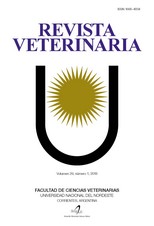Ver ítem
- xmlui.general.dspace_homeCentros Regionales y EEAsCentro Regional CorrientesEEA MercedesArtículos científicosxmlui.ArtifactBrowser.ItemViewer.trail
- Inicio
- Centros Regionales y EEAs
- Centro Regional Corrientes
- EEA Mercedes
- Artículos científicos
- Ver ítem
Terneza, grasa intramuscular y de cobertura en carne de novillos faenados en Corrientes (Argentina)
Resumen
La terneza de la carne es el atributo más apreciado por los consumidores, encontrándose condicionada por muchos factores. El objetivo de este trabajo fue generar información sobre terneza objetiva post maduración de la carne bovina y determinar valores de grasa intramuscular y de cobertura en animales de diferentes biotipos y edades faenados en Corrientes. El trabajo se realizó en un frigorífico tipo A y en la Facultad de Ciencias Veterinarias de la UNNE.
[ver mas...]
La terneza de la carne es el atributo más apreciado por los consumidores, encontrándose condicionada por muchos factores. El objetivo de este trabajo fue generar información sobre terneza objetiva post maduración de la carne bovina y determinar valores de grasa intramuscular y de cobertura en animales de diferentes biotipos y edades faenados en Corrientes. El trabajo se realizó en un frigorífico tipo A y en la Facultad de Ciencias Veterinarias de la UNNE. Se evaluó el músculo longisimus dorsi de novillos tipo Brangus y Braford, de 4, 6 y 8 dientes. Se registró el peso individual de res caliente, así como la conformación y terminación. Las muestras divididas en dos fueron maduradas durante 7 y 14 días envasadas al vacío. La terneza se evaluó por la cizalla de Warner-Bratzler, la grasa total por el método de Soxhlet y la grasa de cobertura con un escalímetro. Se utilizó el análisis de la covarianza a tres vías incluyendo el peso de la res como covariable. El periodo de maduración afectó la terneza. Se registraron diferencias estadísticas entre tratamientos a los 14 días, no así a los 7 días. Durante este periodo, la diferencia de peso lograda se atribuyó al número de dientes y la covariable. El espesor de grasa dorsal se vio afectado por el número de dientes al igual que en la grasa intramuscular, donde además afectó la covariable. La maduración al vacío mejoró la terneza de la carne, siendo este efecto manifiesto en individuos más jóvenes, incrementándose la grasa de cobertura con la edad, no así la grasa intramuscular. La carne producto de animales faenados en la Provincia de Corrientes debe ser considerada de buena calidad, ya que según características de terneza y porcentajes de grasa intramuscular y de cobertura encontradas, responde a las más altas exigencias del mercado.
[Cerrar]
The tenderness of meat is the most valued attribute for the market, being influenced by many factors. The aims of this study were to generate information on post objective tenderness values of beef maturation and to estimate both intramuscular and cover fat
values in animals of different ages and biotypes slaughtered in Corrientes, Argentina. Assay
was performed in a type A slaughterhouse and at the Faculty of Veterinary Science UNNE. Longisimus dorsi
[ver mas...]
The tenderness of meat is the most valued attribute for the market, being influenced by many factors. The aims of this study were to generate information on post objective tenderness values of beef maturation and to estimate both intramuscular and cover fat
values in animals of different ages and biotypes slaughtered in Corrientes, Argentina. Assay
was performed in a type A slaughterhouse and at the Faculty of Veterinary Science UNNE. Longisimus dorsi muscle of 4, 6 and 8 teeth Brangus and Braford steers was evaluated. Individual weight, conformation and termination on the hot carcass were registered. The samples were divided in two groups vacuum packed, maturated for 7 and 14 days. Tenderness was assessed by Warner-Bratzler shear, total fat by the Soxhlet method, and fat coverage with a scaler. We used analysis of covariance for three tracks including the carcass weight as covariable. The period of maturation affected tenderness. There were statistical differences between treatments at 14 days, but not at 7. During this period, the difference of weight achieved was attributable to number of teeth and the covariable. The back fat thickness was
affected by the number of teeth as in intramuscular fat which also affected the covariable. Vacuum maturation accentuated the tenderness of beef, being more evident in younger individuals, with cover fat increasing according age; on the contrary, this effect was not observed for intramuscular fat. Meat products from animals slaughtered in Corrientes must be consid-ered of very good quality, according to the characteristics of tenderness and intramuscular as well as cover fat percentages that meet high market demands.
[Cerrar]

Autor
Ynsaurralde Rivolta, Amanda Eugenia;
Rebak, Gladis I.;
Sanchez, S.;
Capellari, Adriana;
Fuente
Revista Veterinaria / Universidad Nacional del Nordeste 24 (2) : 86-90 (2013)
Fecha
2013
ISSN
1668-4834
1669-6840
1669-6840
Formato
pdf
Tipo de documento
artículo
Palabras Claves
Derechos de acceso
Abierto
 Excepto donde se diga explicitamente, este item se publica bajo la siguiente descripción: Creative Commons Attribution-NonCommercial-ShareAlike 2.5 Unported (CC BY-NC-SA 2.5)
Excepto donde se diga explicitamente, este item se publica bajo la siguiente descripción: Creative Commons Attribution-NonCommercial-ShareAlike 2.5 Unported (CC BY-NC-SA 2.5)


